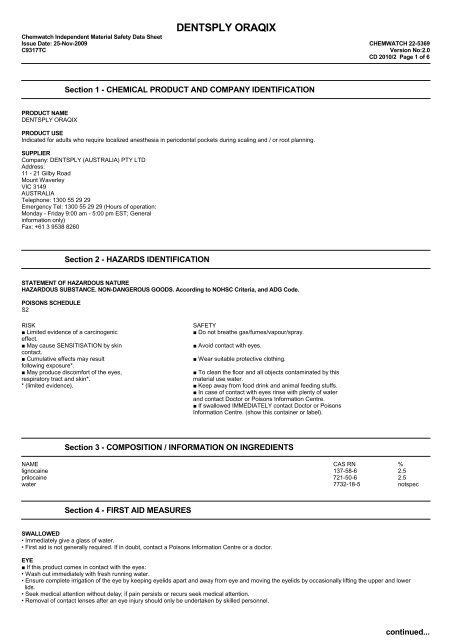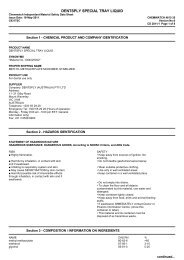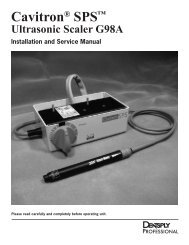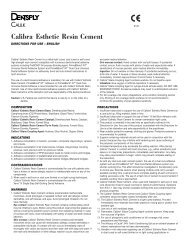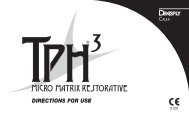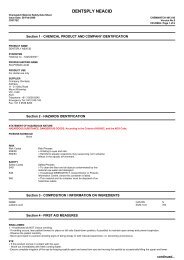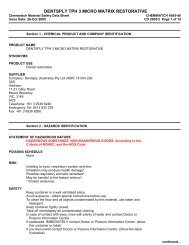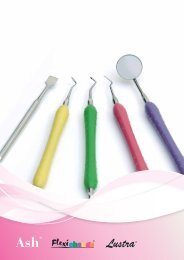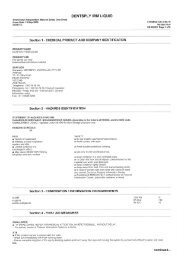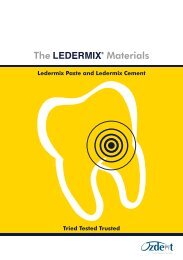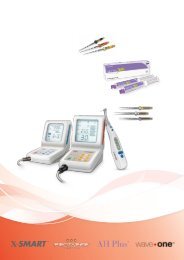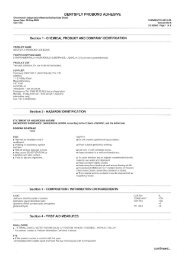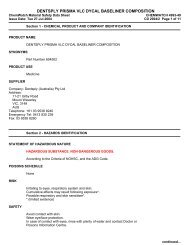Chemwatch Australian MSDS 22-5369 - Dentsply
Chemwatch Australian MSDS 22-5369 - Dentsply
Chemwatch Australian MSDS 22-5369 - Dentsply
Create successful ePaper yourself
Turn your PDF publications into a flip-book with our unique Google optimized e-Paper software.
DENTSPLY ORAQIX<br />
<strong>Chemwatch</strong> Independent Material Safety Data Sheet<br />
Issue Date: 25-Nov-2009 CHEMWATCH <strong>22</strong>-<strong>5369</strong><br />
C9317TC<br />
Version No:2.0<br />
CD 2010/2 Page 1 of 6<br />
Section 1 - CHEMICAL PRODUCT AND COMPANY IDENTIFICATION<br />
PRODUCT NAME<br />
DENTSPLY ORAQIX<br />
PRODUCT USE<br />
Indicated for adults who require localized anesthesia in periodontal pockets during scaling and / or root planning.<br />
SUPPLIER<br />
Company: DENTSPLY (AUSTRALIA) PTY LTD<br />
Address:<br />
11 - 21 Gilby Road<br />
Mount Waverley<br />
VIC 3149<br />
AUSTRALIA<br />
Telephone: 1300 55 29 29<br />
Emergency Tel: 1300 55 29 29 (Hours of operation:<br />
Monday - Friday 9:00 am - 5:00 pm EST; General<br />
information only)<br />
Fax: +61 3 9538 8260<br />
Section 2 - HAZARDS IDENTIFICATION<br />
STATEMENT OF HAZARDOUS NATURE<br />
HAZARDOUS SUBSTANCE. NON-DANGEROUS GOODS. According to NOHSC Criteria, and ADG Code.<br />
POISONS SCHEDULE<br />
S2<br />
RISK<br />
SAFETY<br />
■ Limited evidence of a carcinogenic<br />
■ Do not breathe gas/fumes/vapour/spray.<br />
effect.<br />
■ May cause SENSITISATION by skin<br />
■ Avoid contact with eyes.<br />
contact.<br />
■ Cumulative effects may result<br />
■ Wear suitable protective clothing.<br />
following exposure*.<br />
■ May produce discomfort of the eyes,<br />
■ To clean the floor and all objects contaminated by this<br />
respiratory tract and skin*.<br />
material use water.<br />
* (limited evidence). ■ Keep away from food drink and animal feeding stuffs.<br />
■ In case of contact with eyes rinse with plenty of water<br />
and contact Doctor or Poisons Information Centre.<br />
■ If swallowed IMMEDIATELY contact Doctor or Poisons<br />
Information Centre. (show this container or label).<br />
Section 3 - COMPOSITION / INFORMATION ON INGREDIENTS<br />
NAME CAS RN %<br />
lignocaine 137-58-6 2.5<br />
prilocaine 721-50-6 2.5<br />
water 7732-18-5 notspec<br />
Section 4 - FIRST AID MEASURES<br />
SWALLOWED<br />
• Immediately give a glass of water.<br />
• First aid is not generally required. If in doubt, contact a Poisons Information Centre or a doctor.<br />
EYE<br />
■ If this product comes in contact with the eyes:<br />
• Wash out immediately with fresh running water.<br />
• Ensure complete irrigation of the eye by keeping eyelids apart and away from eye and moving the eyelids by occasionally lifting the upper and lower<br />
lids.<br />
• Seek medical attention without delay; if pain persists or recurs seek medical attention.<br />
• Removal of contact lenses after an eye injury should only be undertaken by skilled personnel.<br />
continued...
DENTSPLY ORAQIX<br />
<strong>Chemwatch</strong> Independent Material Safety Data Sheet<br />
Issue Date: 25-Nov-2009 CHEMWATCH <strong>22</strong>-<strong>5369</strong><br />
C9317TC<br />
Version No:2.0<br />
CD 2010/2 Page 2 of 6<br />
Section 4 - FIRST AID MEASURES<br />
SKIN<br />
■ If skin contact occurs:<br />
• Immediately remove all contaminated clothing, including footwear.<br />
• Flush skin and hair with running water (and soap if available).<br />
• Seek medical attention in event of irritation.<br />
INHALED<br />
• If fumes or combustion products are inhaled remove from contaminated area.<br />
• Lay patient down. Keep warm and rested.<br />
• Prostheses such as false teeth, which may block airway, should be removed, where possible, prior to initiating first aid procedures.<br />
• Apply artificial respiration if not breathing, preferably with a demand valve resuscitator, bag-valve mask device, or pocket mask as trained.<br />
Perform CPR if necessary.<br />
NOTES TO PHYSICIAN<br />
■ When systemic reaction to local anaesthetic occurs, steps should be taken to maintain circulation and respiration and control convulsions. A clear<br />
airway should be established and oxygen given together with assisted ventilation if necessary.<br />
Metabolism of amide-type anaesthetics occurs in the liver and in some cases in the kidney. Because these undergo extensive and rapid hepatic<br />
metabolism, only about 1/3 of an oral dose reaches the systemic circulation.<br />
Section 5 - FIRE FIGHTING MEASURES<br />
EXTINGUISHING MEDIA<br />
• There is no restriction on the type of extinguisher which may be used.<br />
• Use extinguishing media suitable for surrounding area.<br />
FIRE FIGHTING<br />
• Alert Fire Brigade and tell them location and nature of hazard.<br />
• Wear full body protective clothing with breathing apparatus.<br />
• Prevent, by any means available, spillage from entering drains or water course.<br />
• Use water delivered as a fine spray to control fire and cool adjacent area.<br />
FIRE/EXPLOSION HAZARD<br />
• The material is not readily combustible under normal conditions.<br />
• However, it will break down under fire conditions and the organic component may burn.<br />
• Not considered to be a significant fire risk.<br />
• Heat may cause expansion or decomposition with violent rupture of containers.<br />
Combustion products include: carbon dioxide (CO2), carbon monoxide (CO), hydrogen chloride, phosgene, nitrogen oxides (NOx), other pyrolysis products<br />
typical of burning organic material.<br />
May emit poisonous fumes.<br />
May emit corrosive fumes.<br />
FIRE INCOMPATIBILITY<br />
• Avoid contamination with oxidising agents i.e. nitrates, oxidising acids, chlorine bleaches, pool chlorine etc. as ignition may result.<br />
HAZCHEM<br />
None<br />
PERSONAL PROTECTION<br />
Glasses:<br />
Chemical goggles.<br />
Respirator:<br />
Particulate<br />
Section 6 - ACCIDENTAL RELEASE MEASURES<br />
MINOR SPILLS<br />
• Remove all ignition sources.<br />
• Clean up all spills immediately.<br />
• Avoid breathing vapours and contact with skin and eyes.<br />
• Control personal contact by using protective equipment.<br />
MAJOR SPILLS<br />
■ Moderate hazard.<br />
• Clear area of personnel and move upwind.<br />
• Alert Fire Brigade and tell them location and nature of hazard.<br />
• Wear breathing apparatus plus protective gloves.<br />
• Prevent, by any means available, spillage from entering drains or water course.<br />
Personal Protective Equipment advice is contained in Section 8 of the <strong>MSDS</strong>.<br />
continued...
DENTSPLY ORAQIX<br />
<strong>Chemwatch</strong> Independent Material Safety Data Sheet<br />
Issue Date: 25-Nov-2009 CHEMWATCH <strong>22</strong>-<strong>5369</strong><br />
C9317TC<br />
Version No:2.0<br />
CD 2010/2 Page 3 of 6<br />
Section 7 - HANDLING AND STORAGE<br />
PROCEDURE FOR HANDLING<br />
• DO NOT allow clothing wet with material to stay in contact with skin.<br />
• Avoid all personal contact, including inhalation.<br />
• Wear protective clothing when risk of exposure occurs.<br />
• Use in a well-ventilated area.<br />
• Prevent concentration in hollows and sumps.<br />
SUITABLE CONTAINER<br />
• Packaging as recommended by manufacturer.<br />
STORAGE INCOMPATIBILITY<br />
• Avoid storage with reducing agents.<br />
STORAGE REQUIREMENTS<br />
• Store in original containers.<br />
• Keep containers securely sealed.<br />
• No smoking, naked lights or ignition sources.<br />
• Store in a cool, dry, well-ventilated area.<br />
Section 8 - EXPOSURE CONTROLS / PERSONAL PROTECTION<br />
EXPOSURE CONTROLS<br />
The following materials had no OELs on our records<br />
• lignocaine: CAS:137- 58- 6<br />
• prilocaine: CAS:721- 50- 6<br />
• water: CAS:7732- 18- 5<br />
PERSONAL PROTECTION<br />
RESPIRATOR<br />
Particulate<br />
EYE<br />
• Safety glasses with side shields.<br />
• Chemical goggles.<br />
• Contact lenses may pose a special hazard; soft contact lenses may absorb and concentrate irritants. A written policy document, describing the<br />
wearing of lens or restrictions on use, should be created for each workplace or task. This should include a review of lens absorption and<br />
adsorption for the class of chemicals in use and an account of injury experience. Medical and first-aid personnel should be trained in their<br />
removal and suitable equipment should be readily available. In the event of chemical exposure, begin eye irrigation immediately and remove contact<br />
lens as soon as practicable. Lens should be removed at the first signs of eye redness or irritation - lens should be removed in a clean environment<br />
only after workers have washed hands thoroughly. [CDC NIOSH Current Intelligence Bulletin 59].<br />
HANDS/FEET<br />
■ NOTE:<br />
• The material may produce skin sensitisation in predisposed individuals. Care must be taken, when removing gloves and other protective equipment, to<br />
avoid all possible skin contact.<br />
• Contaminated leather items, such as shoes, belts and watch-bands should be removed and destroyed.<br />
• Impervious gloves.<br />
OTHER<br />
• Overalls.<br />
• P.V.C. apron.<br />
• Barrier cream.<br />
• Skin cleansing cream.<br />
■ None under normal operating conditions.<br />
ENGINEERING CONTROLS<br />
■ Local exhaust ventilation usually required. If risk of overexposure exists, wear approved respirator.<br />
Section 9 - PHYSICAL AND CHEMICAL PROPERTIES<br />
APPEARANCE<br />
Clear odourless liquid; mixes with water.<br />
PHYSICAL PROPERTIES<br />
Liquid.<br />
continued...
DENTSPLY ORAQIX<br />
<strong>Chemwatch</strong> Independent Material Safety Data Sheet<br />
Issue Date: 25-Nov-2009 CHEMWATCH <strong>22</strong>-<strong>5369</strong><br />
C9317TC<br />
Version No:2.0<br />
CD 2010/2 Page 4 of 6<br />
Section 9 - PHYSICAL AND CHEMICAL PROPERTIES<br />
Mixes with water.<br />
State Liquid Molecular Weight Not Available<br />
Melting Range (°C) Not Available Viscosity Not Available<br />
Boiling Range (°C) Not Available Solubility in water (g/L) M iscible<br />
Flash Point (°C) Not Available pH (1% solution) Not Availabl e<br />
Decomposition Temp (°C) Not Available pH (as supplied) 3.3- 5.5<br />
Autoignition Temp (°C) Not Available Vapour Pressure (kPa) Not Available<br />
Upper Explosive Limit (%) Not Available Specific Gravity (water=1) 1.0<br />
Lower Explosive Limit (%) Not Available Relative Vapour Density Not Available<br />
(air=1)<br />
Volatile Component (%vol) Not Available Evaporation Rate Not Available<br />
Section 10 - CHEMICAL STABILITY AND REACTIVITY INFORMATION<br />
CONDITIONS CONTRIBUTING TO INSTABILITY<br />
• Presence of incompatible materials.<br />
• Product is considered stable.<br />
• Hazardous polymerisation will not occur.<br />
For incompatible materials - refer to Section 7 - Handling and Storage.<br />
Section 11 - TOXICOLOGICAL INFORMATION<br />
POTENTIAL HEALTH EFFECTS<br />
ACUTE HEALTH EFFECTS<br />
■ May produce discomfort of the eyes, respiratory<br />
tract and skin*.<br />
■ * (limited evidence).<br />
CHRONIC HEALTH EFFECTS<br />
■ May cause SENSITISATION by skin contact.<br />
■ Limited evidence of a carcinogenic<br />
effect.<br />
■ Cumulative effects may result following<br />
exposure*.<br />
■ * (limited evidence).<br />
TOXICITY AND IRRITATION<br />
PRILOCAINE:<br />
LIGNOCAINE:<br />
■ unless otherwise specified data extracted from RTECS - Register of Toxic Effects of Chemical Substances.<br />
■ unless otherwise specified data extracted from RTECS - Register of Toxic Effects of Chemical Substances.<br />
■ Contact allergies quickly manifest themselves as contact eczema, more rarely as urticaria or Quincke's oedema. The pathogenesis of contact eczema<br />
involves a cell-mediated (T lymphocytes) immune reaction of the delayed type.<br />
Asthma-like symptoms may continue for months or even years after exposure to the material ceases. This may be due to a non-allergenic condition known<br />
as reactive airways dysfunction syndrome (RADS) which can occur following exposure to high levels of highly irritating compound.<br />
LIGNOCAINE:<br />
TOXICITY<br />
Oral (rat) LD50: 317 mg/kg<br />
Subcutaneous (rat) LD50: 335 mg/kg<br />
Intravenous (Human) TDLo: 16 mg/kg<br />
Intravenous (Human) TDLo: 23 mg/kg<br />
Oral (Mouse) LD50: <strong>22</strong>0 mg/kg<br />
Intraperitoneal (Mouse) LD50: 102 mg/kg<br />
Subcutaneous (Mouse) LD50: 238 mg/kg<br />
Oral (Human) TDLo: 39 mg/kg<br />
Oral (Human) TDLo: 300 mg/kg<br />
Intraperitoneal (Rat) LD50: 133 mg/kg<br />
Intravenous (Rat) LD50: 18 mg/kg<br />
Intravenous (Rabbit) LD: 41 mg/kg<br />
Subcutaneous (Guinea pig) LD50: 120 mg/kg<br />
Intravenous (Guinea pig) LD: 65 mg/kg<br />
Dermal (Rabbit) TDLo: 0.024 mg/kg<br />
Intravenous (Mouse) LD50: 39.4 mg/kg<br />
IRRITATION<br />
Nil Reported<br />
PRILOCAINE:<br />
TOXICITY<br />
Intraperitoneal (rat) LD50: 148 mg/kg<br />
Subcutaneous (rat) LD50: 790 mg/kg<br />
Intravenous (rat) LD50: 56.6 mg/kg<br />
Intraperitoneal (mouse) LD50: 30 mg/kg<br />
IRRITATION<br />
continued...
DENTSPLY ORAQIX<br />
<strong>Chemwatch</strong> Independent Material Safety Data Sheet<br />
Issue Date: 25-Nov-2009 CHEMWATCH <strong>22</strong>-<strong>5369</strong><br />
C9317TC<br />
Version No:2.0<br />
CD 2010/2 Page 5 of 6<br />
Section 11 - TOXICOLOGICAL INFORMATION<br />
Subcutaneous (mouse) LD50: 632 mg/kg<br />
Intravenous (mouse) LD50: 55 mg/kg<br />
Intravenous (rabbit) LD50: 18 mg/kg<br />
Intratracheal (rabbit) LD50: 65 mg/kg<br />
■ Contact allergies quickly manifest themselves as contact eczema, more rarely as urticaria or Quincke's oedema. The pathogenesis of contact eczema<br />
involves a cell-mediated (T lymphocytes) immune reaction of the delayed type.<br />
for prilocaine hydrochloride:<br />
Parenteral (man) LDLo: 12.43 mg/kg/1h - I Nil reported<br />
Altered sleep-time, convulsions recorded.<br />
CARCINOGEN<br />
Anaesthetics, International Agency for Research on Cancer Group 3<br />
volatile<br />
(IARC) - Agents Reviewed by the IARC<br />
Monographs<br />
No data<br />
Section 12 - ECOLOGICAL INFORMATION<br />
Ecotoxicity<br />
Ingredient Persistence: Persistence: Air Bioaccumulation Mobility<br />
Water/Soil<br />
lignocaine HIGH LOW MED<br />
prilocaine HIGH LOW MED<br />
water LOW LOW HIGH<br />
Section 13 - DISPOSAL CONSIDERATIONS<br />
• Containers may still present a chemical hazard/ danger when empty.<br />
• Return to supplier for reuse/ recycling if possible.<br />
Otherwise:<br />
• If container can not be cleaned sufficiently well to ensure that residuals do not remain or if the container cannot be used to store the same<br />
product, then puncture containers, to prevent re-use, and bury at an authorised landfill.<br />
• Where possible retain label warnings and <strong>MSDS</strong> and observe all notices pertaining to the product.<br />
Legislation addressing waste disposal requirements may differ by country, state and/ or territory. Each user must refer to laws operating in their<br />
area.<br />
A Hierarchy of Controls seems to be common - the user should investigate:<br />
• Reduction.<br />
Consult State Land Waste Management Authority for disposal.<br />
Section 14 - TRANSPORTATION INFORMATION<br />
HAZCHEM:<br />
None (ADG7)<br />
NOT REGULATED FOR TRANSPORT OF DANGEROUS GOODS: ADG7, UN, IATA, IMDG<br />
Section 15 - REGULATORY INFORMATION<br />
POISONS SCHEDULE<br />
S2<br />
REGULATIONS<br />
Regulations for ingredients<br />
lignocaine (CAS: 137-58-6) is found on the following regulatory lists;<br />
"Australia Inventory of Chemical Substances (AICS)"<br />
prilocaine (CAS: 721-50-6) is found on the following regulatory lists;<br />
"Australia Inventory of Chemical Substances (AICS)"<br />
TAP WATER (CAS: 7732-18-5) is found on the following regulatory lists;<br />
"Australia Inventory of Chemical Substances (AICS)","IMO IBC Code Chapter 18: List of products to which the Code does not apply","OECD Representative<br />
List of High Production Volume (HPV) Chemicals"<br />
continued...
DENTSPLY ORAQIX<br />
<strong>Chemwatch</strong> Independent Material Safety Data Sheet<br />
Issue Date: 25-Nov-2009 CHEMWATCH <strong>22</strong>-<strong>5369</strong><br />
C9317TC<br />
Version No:2.0<br />
CD 2010/2 Page 6 of 6<br />
Section 15 - REGULATORY INFORMATION<br />
No data for <strong>Dentsply</strong> Oraqix (CW: <strong>22</strong>-<strong>5369</strong>)<br />
Section 16 - OTHER INFORMATION<br />
Denmark Advisory list for selfclassification of dangerous substances<br />
Substance CAS Suggested codes<br />
lignocaine 137- 58- 6 Xn Carc3; R40<br />
prilocaine 721- 50- 6 Xn Carc3; R40<br />
■ Classification of the preparation and its individual components has drawn on official and authoritative sources as well as independent review by<br />
the <strong>Chemwatch</strong> Classification committee using available literature references.<br />
A list of reference resources used to assist the committee may be found at:<br />
www.chemwatch.net/references.<br />
■ The (M)SDS is a Hazard Communication tool and should be used to assist in the Risk Assessment. Many factors determine whether the reported Hazards<br />
are Risks in the workplace or other settings.<br />
This document is copyright. Apart from any fair dealing for the purposes of private study, research, review or<br />
criticism, as permitted under the Copyright Act, no part may be reproduced by any process without written<br />
permission from CHEMWATCH. TEL (+61 3) 9572 4700.<br />
Issue Date: 25-Nov-2009<br />
Print Date: 8-Jul-2010<br />
This is the end of the <strong>MSDS</strong>.


